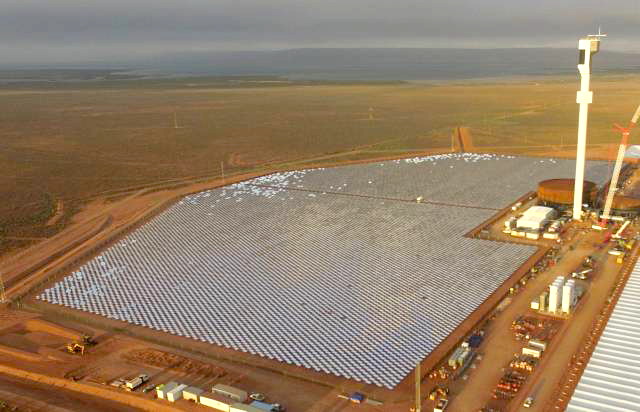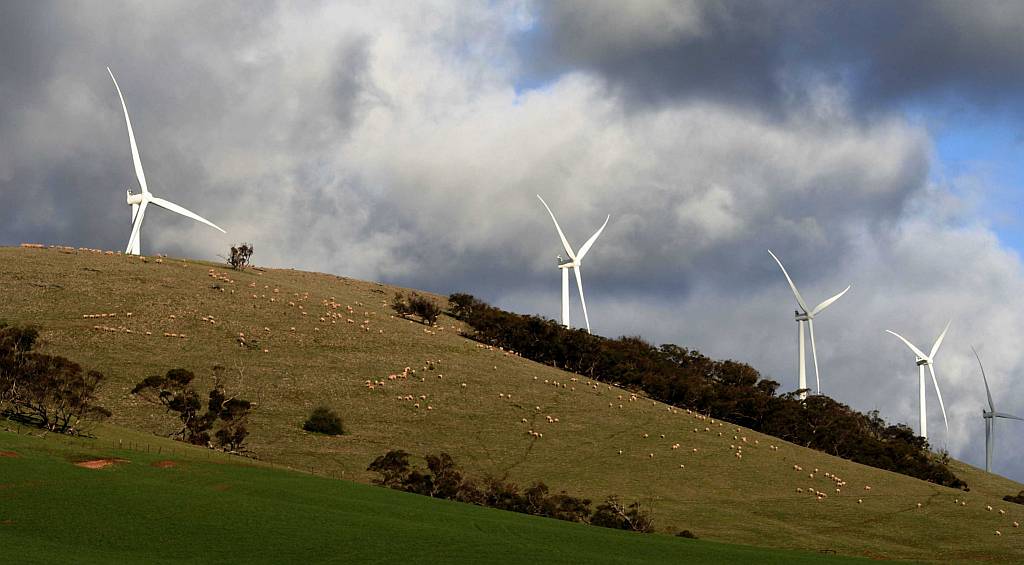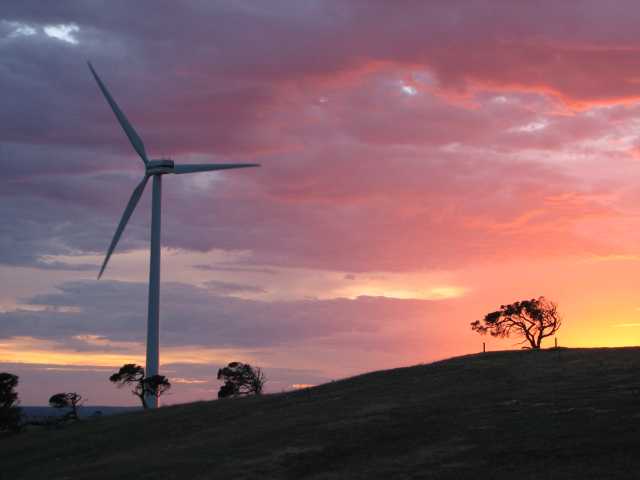I'll say a bit about why the attack, then I'll say a bit about why the attack
is
nonsensical, finally I'll give the
facts.
| |
| Sundrop Farm, Port Augusta, South Australia
|
|---|

| | Innovatively using solar power and sea water to grow
tomatoes
| |
- They have largely given up trying to convince everyone that climate isn't
changing and the change isn't disastrous.
The evidence is now irrefutable.
Anyone with an IQ above 50 who has not been living in a cave for the last 20
years and is not in total denial should know the facts of the matter.
(Why accept climate science?)
- South Australia has far more new renewable energy than any other Australian state; 37% wind energy and 4% solar at the time of writing.
All of this built in the last twelve years.
This is terrifying the fossil fuel industry bosses because SA is going
further and they can see the rest of Australia going the same way.
- With only a very few years to go to 2020 when Australia must have 33 Twh
of renewably generated electricity annually there is a resurgence in the
building of wind farms, large-scale solar power stations are becoming
run-of-the-mill and solar-thermal power stations with storage are being
proposed around the country.
- The price of solar PV has fallen so low that it is now competing with
wind, which is already cheaper than new coal-fired power stations and much
cheaper than nuclear.
- Following the Paris climate change agreement late last year
Carbon Tracker has demonstrated that there are two trillion (that's two
million
million) dollars worth of fossil fuel deposits which can never be burned.
That means that the market value of fossil fuel companies will have to be
down-graded by two trillion dollars!
The super-wealthy who run the fossil fuel industry know that there's a
crunch coming, but
the longer they can put off that crunch the more chance they have
to sell their investments while minimising their losses.
Of course fossil fuel owners and their lackeys are attacking the renewable
energy industry.
"Offence is the best means of defence."
- The high wholesale spot power prices that triggered the attack were in a
few weeks of July 2016.
The last significant wind farm to come online in SA was
Snowtown Stage 2 back
in the middle of 2014.
Since then only a half dozen more turbines have come
on-stream (the first few of the
Hornsdale Wind Farm).
People who don't care about rational argument often confuse association with
causality, but in this case the claimed cause came two years before the
effect – isn't that a bit much for any reasonable person to swallow?
| |
| State with the most high price events by year
|
|---|
| Year | >$300 | >$1000
|
|---|
| 2010 | NSW | SA
|
|---|
| 2011 | NSW | NSW
|
|---|
| 2012 | Qld | SA
|
|---|
| 2013 | Qld | SA
|
|---|
| 2014 | SA | Qld
|
|---|
| 2015 | Qld | Qld
|
|---|
|
- Dylan McConnell and Mike Sandiford, Melbourne Energy Institute, University of
Melbourne; 2016/08/11; wrote a report titled
'Winds of Change: An analysis of recent changes in the
South Australian electricity market'.
In 55 pages the report went into great detail, but sufficient for this page
is the gist of a table on page 20.
The table showed the number of high wholesale electricity price events in the
four mainland states on the Australian National Electricity Market from 2010
to the time of writing.
Note that from 2010 to 2015 Queensland had the greatest number of high price
events in five cases, SA in four cases, NSW in three cases.
SA was by no means outstanding in the number of high price events.
| |
| Wind power in South Australia
|
|---|

| | One of the turbines of Clements Gap Wind Farm
| |
- A quote from
Richard Denniss of The Australia Institute:
"The average annual wholesale price of electricity in South Australia has
fallen by 40% since 2007-08. Scary isn't it.
The same old bedwetters in the media and business community have been spooked
by some big spikes in the spot price of electricity in South Australia.
Cooler heads have highlighted that the vast majority of industrial and
domestic customers are on long run contracts, that renewables sometimes push
the electricity spot price below zero, and that there have been no blackouts.
But facts are no fun."
So, wholesale prices, apart from this anomaly of a few weeks, have fallen
since 2007-08, in the same period when many or most of SA's wind farms were
built.
- The high spot prices in the SA Wholesale electricity market have more to
do with gas prices than with wind or solar.
Richard Denniss again:
"Spot wholesale prices of gas in the Adelaide market
have risen from around $3.50 to $7.50 per gigajoule in the last 18 months as
a direct result of government policy to link our formerly landlocked east
coast gas pipeline to the seaborne gas market."
Also see the statement by Minister Josh Frydenberg below.
- The biggest interstate electricity interconnector, which allows SA to
import or export power to the eastern states was undergoing upgrading and
that upgrading was held up by the wet and windy weather.
This decreased the flexibility that is normally in the market.
- The closing of the Northern (coal-fired) Power Station at Port Augusta
and limits on the interconnector reduced competition, making it easier for
those who ran the gas-fired power stations to 'play the system', push up
wholesale prices, and their profits.
- Even Josh Frydenberg,
Liberal Federal Minister
for Energy and Environment, and no friend of renewable energy, was honest
enough to
say of the period of volatility:
"The main reason was the Heywood Interconnector was being upgraded and that
supplies electricity from Victoria, coal-fired electricity, into South
Australia.
The other reason at play here for those – for the wild fluctuations was
the increase in demand for electricity because there was a cold snap and that
played there.
Then spot prices for gas were very high."
This was broadcast on 2016/07/27.
| |
| Wind turbines sharing a hill with sheep
|
|---|

| | Snowtown Wind Farm
|
|
|
|
|
| Sunrise at a wind farm
|
|---|

| | Canunda Wind Farm
| |
As Federal Energy Minister Josh Frydenberg said (above), some of the reasons
for the spot price volatility were:
- the upgrading of the Heywood Interconnector;
- increased demand for electricity because of a cold snap;
- and very high spot prices for gas.
There was a very important additional factor: uncompetative action in the
electricity supply industry.
Well before the recent events, in a November 2012
report prepared for the Energy Users Association of Australia, the author
Bruce Mountain said:
"The analysis in this document has concluded that concerns over the
competitiveness of the wholesale electricity market in South Australia over
the period from 2008 to 2011 seem to be well founded."
and
"The analysis in this paper suggests that spot market prices in these periods
reflect the exercise of market power rather than scarce supply.
The South Australian electricity system appears to have ample capacity even at
the times of peak demand."
Bruce Mountain is Director of CME (Carbon+energy markets).
The uncompetative activity of some in the electricity generation and
transmission industry increased the spot prices in South Australia.
Some points on increasing the amount of renewable energy in the
system
South Australia has a high percentage of renewables and renewables are
intermittent.
The wind doesn't blow to order and the sun doesn't shine just when it suites
us.
That's the way of most forms of renewable energy, we don't dig or pump them
out of the ground as we need them, we have to use them as they are available.
The world must transition away from fossil fuels to renewables.
The transition is essential, it is urgent, but it will not necessarily be
easy.
In the short term gas-fired generation can fill in the gaps left by renewables.
There's no fundamental problem there, but the South Australian situation
shows that some tweaking of the way the generation system operates is needed.
In the long term we must have energy storage.
This means more use of batteries, pumped hydro-power, solar-thermal with
storage, possibly things like using excess electricity to convert water into
hydrogen and oxygen and storing that until it is needed.
None of this is as cheap and easy as burning gas or coal as they are needed;
there will be increased costs.
We have become
addicted to cheap and
dirty energy and that addiction is hugely damaging; we have to kick the
habit.
There will be some pain in the transition, but that is far better than the
alternative.



